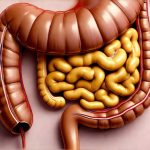The human experience is profoundly interwoven with our digestive system – far beyond simply processing food. It’s a site where physical nourishment meets emotional wellbeing, often in ways we don’t consciously recognize. Many individuals report a surprising sense of lightness, not just physically but emotionally, following a bowel movement or period of significant digestive release. This isn’t merely anecdotal; it reflects the deep interconnectedness between the gut and the brain – what is commonly known as the gut-brain axis. Understanding this connection can unlock insights into how we process emotions and navigate mental wellbeing, revealing that physical release can be a powerful catalyst for emotional clarity.
For centuries, various healing traditions have recognized the link between physical stagnation and emotional blockage. Traditional Chinese Medicine, Ayurveda, and even early psychological theories touched upon the idea that unresolved feelings can become “stuck” within the body, manifesting as physical discomfort or illness. Modern neuroscience is now confirming these ancient perspectives with concrete evidence of bidirectional communication between our digestive system and our brain. The vagus nerve, a crucial component of this axis, acts as a direct line of communication, constantly relaying information about gut health to the brain and vice versa. This means that what happens in your gut profoundly impacts your emotional state and cognitive function—and conversely, your emotional state can significantly influence your digestion. If you’re experiencing consistent issues, exploring digestive trouble might be a good start.
The Gut-Brain Axis: A Two-Way Street
The gut-brain axis isn’t a one-way street; it’s a complex, dynamic interplay. Your brain influences everything from the speed of digestion to the composition of your gut microbiome – the trillions of bacteria residing in your digestive tract. Stress and anxiety, for example, can slow down digestion, leading to constipation or bloating, while positive emotions might facilitate smoother processing. But perhaps even more fascinating is how the gut communicates with the brain. The microbiome produces neurotransmitters—chemical messengers like serotonin (often called the “happy hormone”) – that directly influence mood, sleep, and cognitive function. A healthy, diverse gut microbiome is therefore crucial not only for physical health but also for mental wellbeing.
This constant communication explains why digestive issues are often accompanied by emotional symptoms. Irritable Bowel Syndrome (IBS), for example, frequently co-occurs with anxiety and depression. Conversely, individuals experiencing significant emotional distress might find themselves struggling with intense work problems. The release that many experience after a bowel movement isn’t just about eliminating waste; it’s about potentially releasing pent-up emotional energy that has become intertwined with the physical stagnation within the body. It’s a tangible experience of restoring balance to this crucial axis, offering a sense of lightness and renewed clarity. Experiencing digestive recovery can also be helpful after a period of stress.
The microbiome itself plays an active role in this process. Certain bacterial strains are known to produce GABA, a neurotransmitter that helps calm the nervous system, while others can influence cortisol levels—the hormone associated with stress. A disrupted gut microbiome (dysbiosis) can therefore contribute to emotional imbalances, making it harder to cope with stress and regulate mood. Supporting a healthy gut microbiome through diet, lifestyle choices, and potentially probiotic supplementation can be a powerful step towards both digestive and emotional wellbeing.
Understanding Emotional Stagnation & Release
Emotional stagnation isn’t necessarily about consciously dwelling on negative thoughts or experiences. It can manifest as a subtle sense of unease, restlessness, or feeling “off.” Often, these feelings are tied to unresolved emotions that haven’t been fully processed – perhaps past traumas, unacknowledged grief, or suppressed anger. These emotions can become lodged within the body, creating physical tension and contributing to digestive sluggishness. Think about how stress often manifests as a “knot” in your stomach or tightness in your shoulders.
- When we experience stressful events, our bodies initiate a fight-or-flight response, releasing hormones like cortisol and adrenaline.
- If this response is chronically activated, it can lead to inflammation and disrupt digestive function.
- This creates a vicious cycle where physical discomfort reinforces emotional distress, and vice versa.
The act of releasing through digestion—whether via bowel movement, sweating, or even crying – can be seen as a way of physically expelling some of that accumulated tension. It’s not about solving the underlying emotional issue in that moment, but rather creating space for healing and processing. It’s akin to clearing debris from a clogged pathway, allowing energy to flow more freely. The subsequent feeling of clarity often stems from this restored sense of energetic flow. Understanding cultural diet changes can also provide insight into digestive responses.
The Role of Vagal Tone & Nervous System Regulation
Vagal tone refers to the activity level of the vagus nerve. A higher vagal tone indicates a more resilient nervous system – one that is better equipped to handle stress, regulate emotions, and maintain overall wellbeing. Stimulating the vagus nerve can have profound effects on both physical and mental health. Interestingly, activities that promote digestive release can also stimulate the vagus nerve, contributing to increased vagal tone.
One way to actively improve vagal tone is through techniques like:
1. Deep diaphragmatic breathing – slow, controlled breaths that engage the diaphragm.
2. Cold exposure – brief periods of cold water immersion or showers (always consult with a healthcare professional first).
3. Meditation and mindfulness practices – cultivating present moment awareness can help calm the nervous system.
Digestive release itself acts as a form of vagal stimulation, sending signals to the brain that promote relaxation and reduce stress. The physical act of elimination can trigger a sense of completion and resolution, further enhancing vagal tone. This is why some people find that even just acknowledging the need to “let go” – both physically and emotionally – can be incredibly liberating. Recognizing emotional lockdown can be a first step toward healing.
Practical Steps for Cultivating Emotional Clarity Through Digestive Wellbeing
Cultivating emotional clarity isn’t about forcing yourself to feel good; it’s about creating an environment within your body and mind that supports natural release and processing. This begins with paying attention to your digestive health and recognizing the signals your body is sending you. Here are a few practical steps:
- Prioritize mindful eating: Slow down, chew thoroughly, and savor each bite. This aids digestion and allows you to connect with your food on a deeper level.
- Hydrate adequately: Water is essential for healthy digestion and overall wellbeing.
- Incorporate fiber-rich foods: Fiber supports regular bowel movements and nourishes the gut microbiome.
- Manage stress: Find healthy ways to cope with stress, such as exercise, yoga, meditation, or spending time in nature.
- Consider a food journal: Tracking what you eat and how it makes you feel can help identify potential sensitivities or trigger foods.
- Practice self-compassion: Be kind to yourself and acknowledge that emotional healing is a process, not a destination.
Remember, the connection between digestion and emotions is deeply personal. What works for one person may not work for another. The key is to listen to your body, experiment with different approaches, and find what supports your wellbeing. The feeling of clarity after digestive release is a powerful reminder of this interconnectedness—a tangible experience that invites us to cultivate greater awareness and self-care in all aspects of our lives. If you’ve recently made clean eating changes, be patient with your body as it adjusts.


















